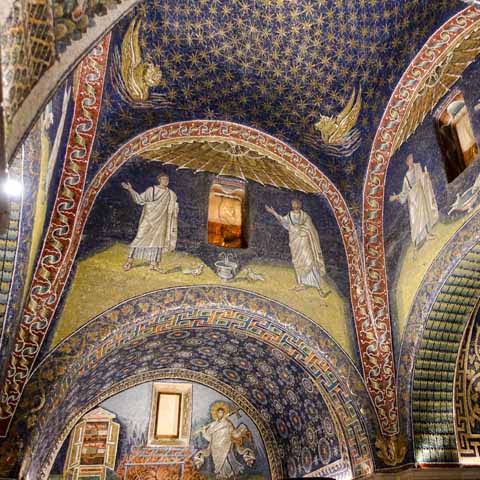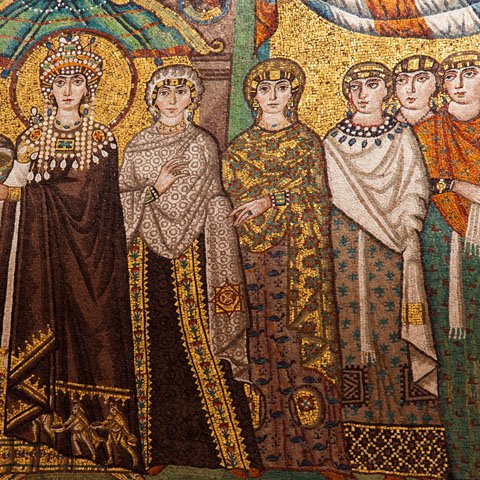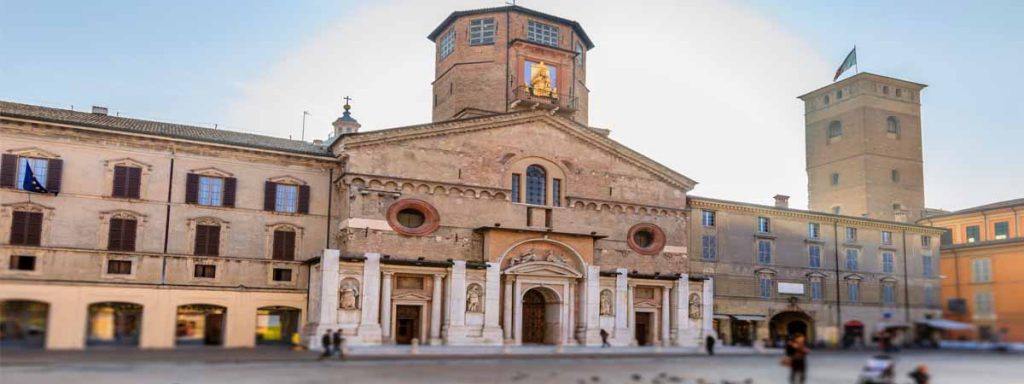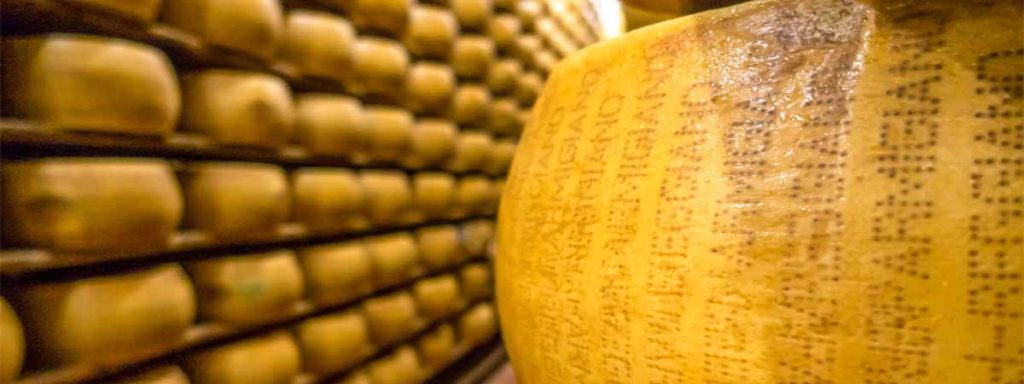Ravenna, located in northeastern Italy, is considered by some to be a cultural mecca. The city is one of the few locations in the country with such a high concentration of unique architecture, fascinating mosaic artwork, legendary literary giants, and a love for music. This quiet and unassuming city is filled with treasure after treasure for those that wander the charming Italian streets of Ravenna to soak in the local culture of today and years past.
ARCHITECTURE
Some view Turin as the birthplace of Italian cinema, and, over the years, the city’s role in the cinematic industry has only grown. Typically, during the month of November, the city of Turin hosts the Torino Film Festival, which is Italy’s second largest film festival. This international celebration of film features movie screenings at the Mole Antonelliana, a distinctive Turin structure recognized primarily by its unique spire. The Italian National Museum of Cinema is also located here and is home to famous movie memorabilia from a variety of different film genres as well as artifacts related to the history of film.
November also ushers in the Turin Chocolate Festival. Called CioccolaTò (which plays on the Italian word for chocolate and the city’s name), this festival is a definite must for hardcore foodies. During this literally mouthwatering event, the Piazza San Carlo is overtaken by more than one hundred twenty Italian chocolate makers. If you visit during the festival, expect to try some free samples of a number of decadently flavored chocolates.
In the month of December, the city center of Turin is transformed with light installations designed by local artists. Known as Luci d’artista (artist lights), the uniqThe United Nations Educational Scientific and Cultural Organization (UNESCO) has designated eight World Heritage Sites in the city of Ravenna, all primarily for their outstanding displays of historical and intricate mosaic art. These sites include the Mausoleum of Galla Placidia, Orthodox Baptistry, Archiepiscopal Chapel, Arian Baptistry, Basilica of Sant’Apollinare Nuovo, Mausoleum of Theoderic, Basilica of San Vitale, and Basilica of Sant’Apollinare in Classe.
One of the oldest of these World Heritage Sites is thought to be the fifth-century Mausoleum of Galla Placidia. UNESCO deemed the structure to be one of the best preserved and artistically perfect of all the mosaic monuments. Although the inside of the mausoleum is somewhat small and simple in structural design, the effect of nearly floor to ceiling mosaic artwork is absolutely jaw dropping. In addition to the depiction of a number of Biblical scenes, the mausoleum also contains three sarcophagi which are said to belong to Galla Placidia, her husband Emperor Constantius III, and her brother Emperor Honorius.
The Orthodox Baptistry is thought to have been commissioned by Bishop Urso in the early fifth century. The octagonal shaped building has a brick exterior accented with arched windows that yield a simple but elegant effect. Instead of being entirely mosaics on the interior, the art appears to be divided by tiers, with the bottom tier accented with mostly marble, the middle with stucco-works and the top tier with colorful mosaics that depict Biblical scenes. True to its name, a rebuilt sixteenth-century baptismal font of marble sits in the middle of the building.
The Archiepiscopal Chapel’s primary claim to fame is the fact that it is thought to be the only well-preserved and intact archiepiscopal chapel of the early Christian era still in existence. The sixth century building is sometimes referred to as the Chapel of Sant’Andrea (named after Saint Andrew) and is the smallest of all the UNESCO World Heritage Sites. The majority of the mosaics in the chapel are on the upper portion of the interior of the building and are somewhat unique in that they depict Christ as a warrior. Many of the mosaic scenes in the chapel purposefully contain anti-Arian iconography as the church clergy wanted to distance themselves greatly from the Ostrogothic Arian rulers who once occupied Ravenna.
Of all the UNESCO World Heritage Sites in Ravenna, the sixth century Arian Baptistry is an octagonal building that is rather small in size with a brick exterior, several arched windows, and a dome roof. The highlight of this sightseeing stop for most visitors is the mosaic located on the dome ceiling, which depicts John the Baptist baptizing Christ.
The Basilica of Sant’Apollinare Nuovo was originally established as a primarily Arian church, but in the sixth century was reestablished as a Roman Catholic Church. The exterior of the building is a unique combination of eastern and western influences that features a marble arcade or walkway and a rather tall bell tower to the right. The interior of the building is almost stark in appearance compared to the other World Heritage Sites, but it does help the mosaics in the upper portion of the building to truly shine. Unfortunately, many of the original mosaics in this building were lost to war, time, weather, and inferior construction over the years. However, that fact does not diminish the glory of the remaining mosaic artwork.
The Mausoleum of Theoderic is a plain circular building located outside the historic city center of Ravenna. The structure is actually home to the tomb of Ostrogth King Theodoric. It is thought to be one of the only surviving and intact tombs from a barbarian king circa the Middle Ages. This sixth century building is extremely simple in nature on both the exterior and the interior, with the structure’s historical significance being the main draw.
The sixth century Basilica of San Vitale is one of the more beautiful, inside and out, of the Ravenna World Heritage Sites. The three-story octagonal building’s exterior is primarily made of brick and features arched windows and a central dome. The interior of the building is absolutely stunning with wall to wall decorative accents and intricate art that the eye is able to take in at one time.
The colorful mosaics dominate the top half of the building and many of the Biblical scenes depict important figures mentioned in the Old Testament. The Basilica of San Vitale is definitely a must-see before leaving Ravenna.
Last but not least is the Basilica of Sant’Apollinare in Classe which is considered to be the largest Late Antiquity (or Byzantine) church in the city. Rather than being within walking distance of the other World Heritage Sites of Ravenna, this basilica is located almost five miles away. The sixth-century brick structure is stately with many beautiful arched windows, and the interior is a lovely combination of frescoes and mosaics.ue event dates back to 1998. During the weeks leading up to Christmas, the streets of Turin as well as its main squares and most famous monuments, such as the Mole Antonelliana, become part of an open-air museum, making Turin’s fabulous city center even more magical.
ART
Although Ravenna is known for some historical pieces of art that are intricate stone carvings of statues, sarcophagi, and wall hangings, the city is world renowned for its mesmerizing Byzantine mosaic artwork.
In many Italian churches the floors are often the focus for fascinating mosaic patterns. However, in Ravenna churches and in most of the city’s World Heritage Sites are dozens of simply stunning hand-crafted mosaic artworks that in many ways are the defining characteristics of these structures.
To simply label the art mosaic seems almost unfair. These fascinating creations are so intricate and detailed that at first glance at a distance, they appear to be magnificent paintings. Upon closer inspection, visitors will see that the image and décor in front of them is the overall effect of thousands of tiny pieces of tile assembled together to depict a typically Biblical scene.
Rather than the Byzantine and Christian mosaics being contained to only the area of the Bible scene itself, they bleed far past it and in many cases engulf the majority of the walls and ceilings of some structures. This time honored and hand laid tradition of mosaic art is what many consider to be Ravenna’s main draw for visitors.
LITTERATURE
Although born in Florence, famed Italian poet Dante Alighieri, sometimes referred to as simply Dante, is most often associated with the city of Ravenna where he passed away in the early fourteenth century. The acclaimed poet was a primarily literary figure in the late middle ages. Dante was exiled from his homeland of Florence after being accused of corruption and financial wrongs by the Guelphs and came to Ravenna. He is considered to have been a large contributor for the Italian literary movement for his masterpieces such as the Divine Comedy. Today, his tomb is connected to the Basilica di San Francesco in Ravenna in an unassuming marble mausoleum.
Lord Byron was a nineteenth-century renowned British nobleman and leading figure of the Romantic Movement. He is said to have lived in Ravenna for a couple of years after falling in love with a local woman. It was during that time he wrote a local favorite, Ravenna Diary, My Dictionary and Recollections.
Nineteenth-century Irish poet and playwright Oscar Wilde was a part of the Aestheticism Movement of portraying deep beauty in art. He is considered important to the city’s literary movement because of a poem, Ravenna, the poet authored in the late nineteenth-century that describes the beauty of the town.
Alexander Blok, a twentieth-century Russian lyrical poet, and twentieth-century German poet Hermann Hesse are both said to have been so inspired by their visits to Ravenna they penned several poems in honor of the city and its beauty.
MUSIC
By and large one of the events Ravenna is best known for is the Ravenna Festival, which is held annually each summer, mainly during the months of June and July. For more than the last twenty-five years the festival has become a celebration of music of many genres including opera, symphonic, chamber, jazz and ethnic music, as well as musical theater, ballet, and other forms of dance.
Rather than all of these celebrations taking place in one main area, planned and impromptu musical events can be found throughout the city in various locations such as city squares, churches, and more. Some of the events typically take place in a few of the city’s eight UNESCO World Heritage Sites in Ravenna, including the Basilica of San Vitale and the Basilica of Sant’Apollinare. The Palazzo Mauro de Andre is also known to host some of these festival concerts.
The local Teatro Alighieri is an opera house in Ravenna which is estimated to have opened in the mid nineteenth century. Historically the theater offered opera performances and still does today. Typically the opera season runs from November to April and presents somewhere around six operas each season.
During the summer of 2015, Italian conductor Riccardo Muti established the Riccardo Muti Italian Opera Academy at the Teatro Alighieri in Ravenna. The objective of the academy is to train young musicians and conductors under the watchful eye and experience of this world-renowned conductor.
CINEMA
Italian film director and screenwriter, Michelangelo Antonioni filmed some scene sequences in his 1964 picture of Red Desert, also referred to as Deserto Rosso, within the Ravenna city limits.
Don't just see Italy, live it.
Your dream trip to Italy has never been closer
No more endlessly scrolling travel sites. Our travel experts will craft the perfect, one-of-a-kind trip just for you.

300+
DESTINATIONS
We offer more Italian destinations than any travel site. Do and see more with Trips 2 Italy.
1 (of a kind)
ITINERARIES
Because your dream trip to Italy should be designed for you, not for the masses.
100%
PEACE OF MIND
From flights and accommodations, to food and activities - we take care of every detail.








